The life of a young academic is nomadic. There is very little certainty, and we tend to roam. Stability and permanence are not usually available to the likes of us. Lei and I both fit into this category, and we are continually grateful for the (relative) stability that has been afforded us of late. Many of you, gentle Readers, are in the same boat.
This year, for me, was typical: I waved goodbye to my old college and decamped for another, halfway across town. (In fact, it is my brother's college, which is pleasantly weird.) There are over thirty colleges in our university, and I have now travelled through seven of them - student at two, lecturer at four, fellow at one. Ever the traveller. Like the character in the old TV series Quantum Leap, I hope that every next leap will be the leap home.
You never know.
My new college is a little older than my old college; however, it is not New College, which is one of the oldest colleges. My new college is newer than New - by a few centuries, in fact, being founded when Shakespeare was seven years old.
The city is never this sunny. Ever.
With the coming of the new Michaelmas term, a new batch of Freshers throw themselves willingly into the fray. Wide-eyed new souls to be forged, manipulated, and bent to the evil will of their tutors. Before the chaos of "1st week" begins, I enjoy the last fleeting wisps of summer freedom in this, "0th week". That means tea.
To bid adieu to the departed summer, I select a sample of "Nanpozhai" [nan-poh-djai], kindly provided by Scott of Yunnan Sourcing with my last order. The wrapper is shown above; Scott has returned to the traditional calligraphic renderings of the Hanzi, on a white background. It's simple, it's elegant, and it's probably not going to have evil coloured inks that adversely affect the tea. A fine choice.
I wasn't aware of this until I read Scott's detailed notes (which are always very welcome), but Nanpozhai is the next village over from Bingdaozhai, which is the place in Mengku County (of Lincang prefecture) famous for its centuries-old "mother trees". He has another cake from Bingdao [ice island], which is, appropriately, called "Mushucha" [mother-tree tea]. It will be interesting to see if this Nanpozhai has inherited any of the regions famously cooling, mouth-chilling characteristics.
The leaves are medium-to-large, and reaffirm my confidence in Scott's ability to select healthy, well-handled maocha. As the sample pack is opened, a fruity aroma forcefully elbows its way out of the bag.
As with most of the Yunzhiyuan cakes, this brews a healthy yellow, which unhurriedly turns a dense yellow as the action of the air works upon it. Perhaps unsurprisingly, it is most cooling on the tongue. However, it combines with a clean fruity bouquet, much like that of the dry leaves.
Each of us has our own tastes in pu'ercha, and this cake begins by playing quite strongly to mine: it has a sweet, cereal-like base, much beloved in Lincang teas, with a great deal of tobacco and other heavy flavours to keep me happy. Over the top of all this develops a minty freshness of chilling Bingdao.
Later infusions build in kuwei [bitter taste], and it pushes out into a sharp, citric territory that makes me think twice about loving it too much - although it is not at all unpleasant. By the end of the session, I am left with a gentle soup of low, decent activity. There is a good quantity of contents to be found in the leaves, and it has the sheer trousers to do well after a few years, I imagine. The charm of the first infusions wears off quickly, and this talks me out of buying a cake - but, if your shelves have room for a most interesting Lincang cake, comprising Bingdao ice with Mengku cereal, this is definitely worth at least sampling.
Let the term commence!

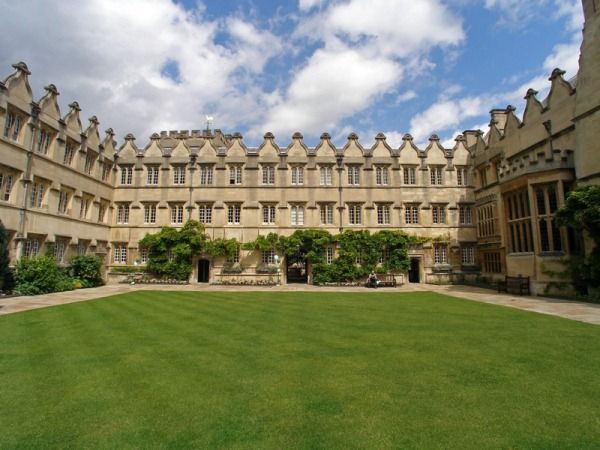
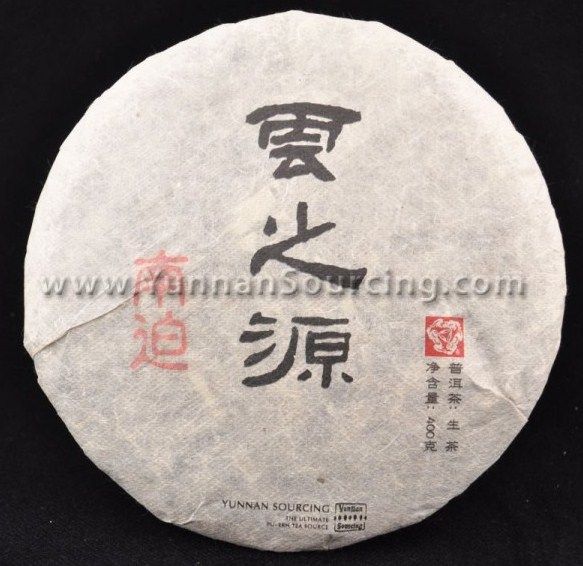
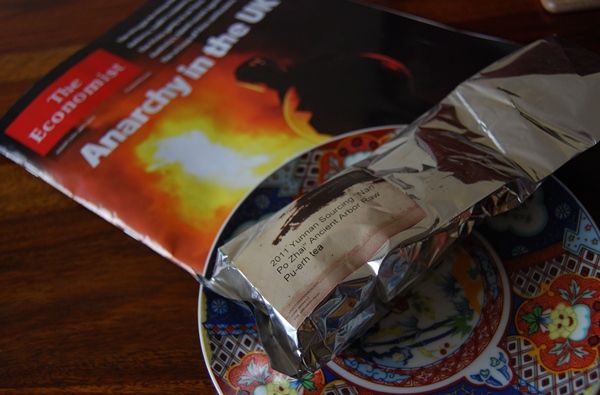
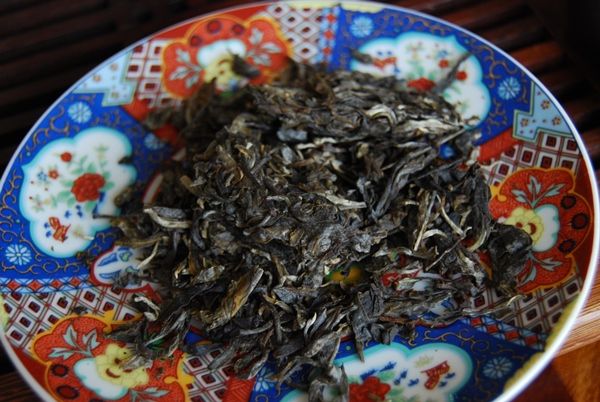
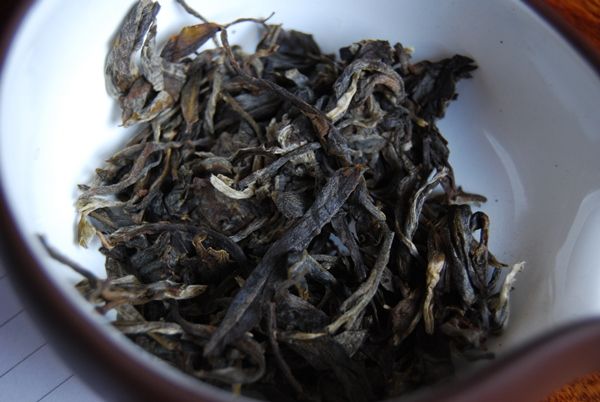

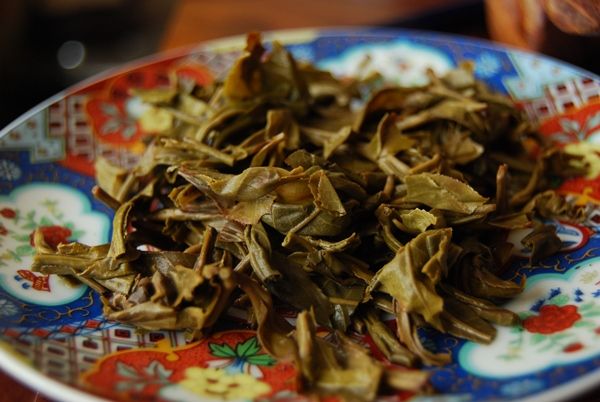
How funny, I acctually sampled the Nan Po Zhai this morning, just a few hours ago.
ReplyDeleteI'm quite fond of mengku teas in general and this tea was, I think, a great specimen: thick powerful soup with plenty of nice flavours and a hui gan that quickly took over from the not too harsh bitterness, lasting long afterwards. The qi could perhaps have been a bit more pronounced, but the sourness you mention was not that apparent to me.
I would need to revisit this tea a few times before I'll commit to any larger purchases and would also like to compare it more thoroughly to the mentioned Mu Shu Cha which, at first glance, was rather good, however not as excellent as the Nan Po Zhai in my opinion.
Best wishes
Johan
Dear Johan,
ReplyDeleteI also prefer this Nanpozhai to the Mushucha / Bingdao. Not quite enough to buy it, but I enjoyed it nonetheless. I must confess to buying a tong of the Wuliang - more on that later.
Toodlepip,
Hobbes
P.s. Scott's new US venture should be going live soon, where I understand he has further supplies of some of his sold-out classics, such as the lamented 2010 Wangongzhai and 2010 Xikong - both cakes that sold out before I bought them!
I tried this tea too. I liked it a lot, at first. The second time I brewed it, however, it seemed a little bit dull-- without too many changes from infusion to infusion, and lacking a pronounced qi. I did, however, notice the pronounced cooling sentation, which is actually pretty enjoyable. I almost bought a cake of this tea, but ultimately thought my money might be better used toward a slightly better cake.
ReplyDeleteBen
Understood, Ben. Cooling and fresh it is - entirely captivating such that the money flies from my wallet, it is perhaps not.
ReplyDeleteA good cake nonetheless, particularly for those of us with space on the shelves.
Toodlepip,
Hobbes
I also sampled this tea and at first I liked it's complex flowery and fruity taste. But then... Hobbes and other puer lovers, does anybody think it tastes too much like a green tea? Not like an absolutely proper young sheng but rather some kind of green tea made of bigger leaves.
ReplyDelete-- Regards, Serg
Hi, Serg,
ReplyDeleteI had this thought in the back of my mind as a comparator: while it was fresh and green, I must say that I concluded that it didn't taste like a green tea. It is definitely real pu'ercha, I think!
(That said, maocha is a green tea. Heh.)
Toodlepip,
Hobbes
Eastern Mengku tea and NW Jing Gu teas are a lot alike. I think the NW Jing Gu teas are better all around. Many of them have that cooling, and the best of these, like XZH Puzhen, are dynamic in the mouth and throughout the session. That having been said, I think the big problem with E Mengku is that the areas delivering high quality maocha is tiny compared to any of the Lancang/Banna growing areas. Close to the best of these icy teas, most people around here have not had.
ReplyDeleteOne last theory. I think many Xiaguan's strictly sheng tuos (and some cakes) age slowly not because they are compressed tightly, but because the Lincang material that makes up most of it gets better much slower than Banna material. The tightness is to preserve freshness for the longer haul that's needed.
--shah8
I didn't know scott was starting up in the US as well. Entrepreneurial chap that one! But as I'm also in europe it will depend mostly on the price level and shipping cost whether I'll go there or not.
ReplyDeleteI also got a tong of the wuliang and I'm looking forward to reading your notes of it and I'll keep my own comments to my self until then.
The best
Johan
Nice Review Hobbes. Sounds like pretty tasty stuff to me. I must ask, seeing as how I'm from the US: What exactly does Scott's US venture look like? Is he stationing a place in the states to ship tea from? Perhaps I should ask him myself, but considering you've dealt with him far more than I have, I figure you already have all those lovely juicy details.
ReplyDelete-PBR
As is my understanding, the new YS web-site in the US will have higher prices, but allow more instantaneous access to the inventory for those based in the US. I imagine that most Europeans will continue to buy from the original Kunming-based operation. A week or two of extra delivery time doesn't really matter very much to me, and so I'll be buying from China, if the inventories are otherwise similar.
ReplyDeleteToodlepip,
Hobbes
Dear Shah,
ReplyDeleteAn interesting Xiaguan theory - I have not heard such a suggestion before. I was under the impression, however, that most Xiaguan leaves are grown around the Dali area, no?
Toodlepip,
Hobbes
Hey Hobbes,
ReplyDeleteThanks for your post about the NPLZ. This is one of my favorite cakes from Scott's spring offerings from this year.
I generally like teas from this region and I think this is a good example of what the teas from there have to offer.
I wanted to ask as I didn't notice in your post. How did you brew this one?
Also, wanted to see if you had a chance to go back and try the Bulang Jie Liang again as I noticed you felt it was sour as well.
Congrats on the move. Good luck for the coming school year.
All the best,
DP
Thanks to you, I need to visit yunnan sourcing store because it was months since I got any cake from there ;]
ReplyDeleteI have also question - which I think already popped out here few times - how to store big pu'er cakes? I have problems with that, especially because air in my flat is pretty dry and I think it doesn't suit my pu'er. Do you have any advice on this?
Many thanks. I do really love your blog.
Dear DP,
ReplyDeleteI brew all my pu'ercha in an approximately similar manner: a pile of leaves (weight unknown, probably 10g or thereabouts) in my zishahu, named "Zidu". Bottled spring water, brought to the boil in a tetsubin on a hot-plate. Instantaneous "water-in, water-out" infusions, lengthening as the tea wears out. Drink from wenxiangbei/pinmingbei. I don't even think about brewing any more - my body just does it. :)
Thanks for the best wishes! We just had Freshers' week, which was great fun for all.
Toodlepip,
Hobbes
P.s. I haven't tried the Bulang Jieliang yet - which cake was that? A YS variety?
ReplyDeleteDear Aluoben,
ReplyDeleteStorage is a really tricky issue, and I cannot claim to be an expert. I can only tell you what seems to be working for me: storage on open shelves in a room, away from strong odours, strong draughts (although non-stale air movement seems to work), etc.
The dryness is a major concern, I think. We're fortunate to have high humidity in the UK, but I don't know what I'd do if I lived somewhere drier. Some people have adopted storage cabinets, with bowls of standing water - but I couldn't comment on those.
All the best,
Hobbes
Dear DP,
ReplyDeleteApologies, you must have meant the 2010 YS Bulang Jieliang - it completely slipped my mind. I haven't tried it since that initial tasting, and strongly suspect that I may have given it away in one of my past sample-swaps!
Toodlepip,
Hobbes
Hey Hobbes,
ReplyDeleteYes, was referring to the '10 YS Bulang Jieliang.
If you have more of the NPLZ, try it in a porcelain gaiwan as opposed to Xiaodu. I would be curious if you still found the sourness. I know sometimes if my Yixings aren't completely dry, or if I drank a Lao Man 'E or something in them the day before, it can throw the taste off for whatever tea follows.
That said, it is a door that swings both ways. It can also improve the taste of the tea that I find faults in from the gaiwan.
Thanks again for the reply.
-DP
Dear DP,
ReplyDeleteI do have some more of the Nanpozhai - is that what you refer to by "NPLZ"? A gaiwan brew would make a nice change; thanks for the suggestion. :)
All the best,
Hobbes
Hey Hobbes,
ReplyDeleteYes, I meant the NanPo Zhai .
Hopefully, you will notice a difference with the gaiwan... Positive difference that is. I love using my Yixings as well and probably use them 90% of the time, but if I am debating whether to buy a tea or not, I will put it through my cheapy porcelain gaiwan to help me decide to buy it or not.
Once I have a cake in my collection though, I will use any vessel that seems to improve it.
Good luck with it and happy brewing
Take care,
DP
It's definitely worth a go!
ReplyDeleteI'm not sure how much of the citric component can be diminished by using a gaiwan, but there's only one way to find out. :)
Sitting next to the cheaper Wuliang, it's an easy choice...
Toodlepip,
Hobbes
LOL.. I preferred the cheaper Ai Lao Shan to the Wuliang...
ReplyDelete-DP
Such is the fickle nature of the tastes. :)
ReplyDeleteHi Hobbes , I'm looking forward to your notes on Scott's 2011 Wuliang as I've been debating whether or not to pull the trigger for some of this myself just recently - generally speaking my thought's and tastes seem to be remarkably similar to yours . All the best !
ReplyDeleteHmm, the Wuliang notes are scheduled for publication on 22 November! In summary, I loved it - inexpensive, very powerful, and complex enough to hold my interest. It's a "genre tea" - recall that it's in Simao - and is therefore subject to your own tastes. If you like Simao, you'll probably like the Wuliang. :)
ReplyDeleteWhy not buy a sample first? Scott seems to have lots of cakes of that variety, and so there's plenty of time to try it out first, to see if it suits your tastes.
I look forward to reading of your experiences with it, if you do!
All the best,
Hobbes